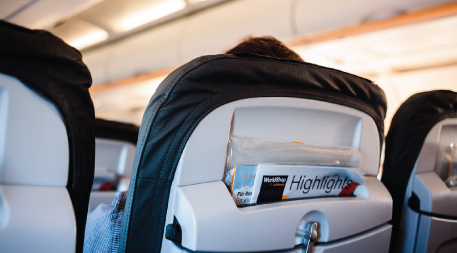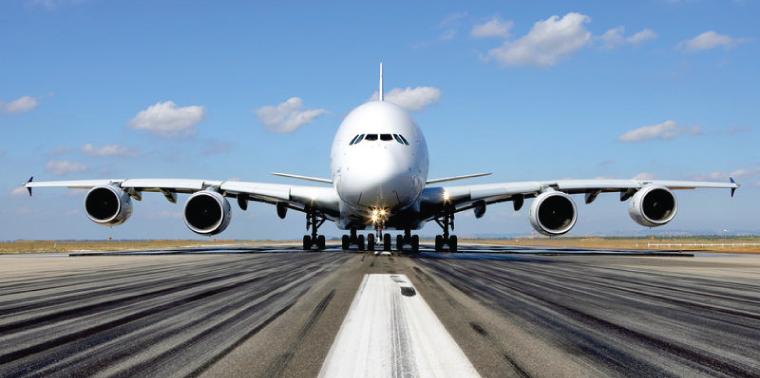October 7, 2013 — An agreement sealed by 191 nations at a meeting last week may have averted, for now, what threatened to become the world’s first climate trade war — a battle between the European Union and the U.S. and several other countries over how to address carbon emissions from air travel. Under the new agreement, the world’s governments pledge to develop a global program for reducing the aviation sector’s climate-altering emissions via market-based solutions such as emissions trading and offsets. The agreement was made in Montreal at a meeting of the International Civil Aviation Organization, a group organized under the United Nations and representing airports, airlines, air traffic controllers, aircraft manufacturers and other aviation industry interests from around the globe.
Currently representing only about 5 percent or less of the global warming potential of human-caused emissions, aviation might seem like a tiny contributor to climate change. But if aviation were its own country, it would be the world’s seventh-largest carbon dioxide emitter, and without interventions, global aircraft emissions are on track to quadruple by 2050, says Annie Petsonk, international counsel and aviation expert at the Environmental Defense Fund.
Research by the Intergovernmental Panel on Climate Change shows that aviation’s influence on the climate extends beyond just its CO2 production, because aircraft also emit sulfur oxides, nitrogen oxides and contrails that alter atmospheric temperatures. Planes release these gases in the upper troposphere and lower stratosphere where their effects are intensified, and the IPCC calculates that aviation emissions produce about 2.7 times the warming effects of CO2 alone.
While the outcome of the political wrangling remains uncertain, one thing is clear — aviation’s future must include measures to reduce its climate effects. With these figures in mind, the EU decided in 2008 to include aviation emissions in its Emissions Trading System, a program for trading greenhouse gas emission allowances among emitters in 31 nations across Europe. The ETS provides an essential component of the EU’s strategy to combat climate change, and the decision to include aviation emissions in the program meant that American carriers flying into and out of Europe would be subject to the program’s rules. In response, Congress passed and President Obama signed a law that prohibits U.S. companies from complying with the EU policy. The EU eventually agreed to hold off on enforcing the rule for foreign airlines to give the international community time to come up with a more comprehensive plan.
While the outcome of the political wrangling remains uncertain, one thing is clear — aviation’s future must include measures to reduce its climate effects. Rather than waiting for politicians to agree on rules, ICAO has come up with its own goals — to improve fleet fuel efficiency by 1.5 percent per year until 2020, then achieve “carbon-neutral growth” beyond 2020. Strategies for meeting these goals fall into four categories — fuels, aircraft technology, operations and market-based mechanisms.
Taming aviation’s climate effects won’t be easy. Compared to road transportation, aviation is already fairly optimized, because the incentives for airlines and manufacturers are almost directly aligned with environmental performance, says Steven Barrett, an aerospace engineer and director of the Laboratory for Aviation and the Environment at the Massachusetts Institute of Technology. Airlines need to minimize fuel costs to stay competitive, and reducing fuel consumption also reduces greenhouse gas production. As a result, there isn’t much low-hanging fruit when it comes to reducing aviation’s climate impacts, Barrett says. While researchers have identified numerous promising strategies for cutting the climate impacts of aircraft, achieving the magnitude of emissions reductions necessary to combat climate change will require an all-out approach that applies all possible methods.
Flying Biofuels
Just as with ground transport, one option for reducing the use of carbon-emitting fossil fuels is to use biofuels instead. In 2011, Lufthansa became the first airline to use biofuel on regularly scheduled flights. Between July 15 and December 27 of that year, a Scaling up production of sustainable biofuel to meet the demand of the world’s fleet is problematic.
Lufthansa Airbus A321 flew 1,187 flights between Frankfurt and Hamburg with one of its engines fueled by a blend of 50 percent biofuel made from jatropha, camelina and animal fats produced under the EU’s sustainability criteria. However, Lufthansa ended the program in early 2012, and in a press release, Joachim Buse, vice president for aviation biofuel at Lufthansa, said the company would only continue the program “if we are able to secure the volume of sustainable, certified raw materials required in order to maintain routine operations.”
Scaling up production of sustainable biofuel to meet the demand of the world’s fleet is problematic, says Kevin Morris, aviation and environment manager for the UK-based aviation trade group ADS. “We don’t see the penetration of biofuels being very high for a while.” And Petsonk notes that as demand for biofuels rises, producing them in a way that truly reduces carbon emissions becomes more difficult. “If you end up having to cut down a lot of forest to start growing biofuel feedstock, have you solved the problem?” she asks.
Other alternative fuels are no more promising. Boeing has developed an unmanned aircraft powered by a hydrogen fuel cell, but hydrogen’s low energy density makes it unsuitable for powering a large aircraft, Morris says.
By Design
Improvements to aircraft design provide another avenue for efficiency gains. Simply reducing the weight of an aircraft substantially cuts its fuel needs. Boeing’s new 787 Dreamliner features a composite carbon-fiber fuselage and wings and an engine that make it 20 percent more fuel-efficient than other comparably sized jumbo jets. The company’s new 737 MAX uses similar technology to create a jet that consumes 13 percent less fuel than other mid-sized planes. Airbus’s A380 similarly improves fuel efficiency by using lightweight composite and aluminum alloys in its construction.

The Lufthansa A321’s thin seats reduce the aircraft’s weight, boosting energy efficiency. Photo by Angelo DeSantis (Flickr/Creative Commons).
Many airlines have also taken measures to cut weight in other ways — for instance, by installing lighter seats and replacing steel containers with carbon fiber ones, says Haldane Dodd, head of communications for the Air Transport Action Group, a coalition of air transportation organizations and businesses.
Barrett cautions, however, that design improvements are long-term, rather than short-term, solutions. That’s because even though newer planes are almost always more efficient than older ones, planes generally remain in the fleet for about 30 years.
Target: Operations
Over the near term, strategies that target operations show the greatest potential, Barrett says. “You don’t need to change the fleet, and you don’t need to change much about the airport infrastructure,” he says.
Sending planes on the most efficient routes, using runways more efficiently and improving air traffic control strategies can reduce emissions on the order of a few percentage points. That may not sound like much, says Barrett, but because these changes can be adopted in the short term, they could have a significant climate impact. “Reducing emissions sooner gives you more bang than reducing them later, so operations is the number one thing right now,” he says.
Still, operations improvement isn’t a slam-dunk. In areas such as Europe where planes may enter multiple sovereign airspaces, coordinating operations isn’t easy, and environmental concerns may take a backseat to security concerns, says Dodd.
Not Enough
Even under the rosiest scenarios, improved fuels, more efficient aircraft and energy-saving operations management don’t add up to the emissions reductions necessary to meet ICAO targets. As a result, says Dodd, some sort of market-based measures such as emissions trading or carbon offsets will be necessary. While individual governments quibble over whether to regulate aviation emissions and how to administer such programs, the new ICAO agreement Surplus offset credits already available in the world’s carbon trading systems could help the aviation industry meet nearly half its targeted emissions reduction by 2050 at a cost of about $4 to $6 per tonne.commits the organization’s 191 member countries to develop a market-based emissions reduction strategy that’s global in scope. Emissions aren’t bound by borders, so any rules must apply across the board to prevent the rules from unfairly pushing the costs to only selected airlines or flights.
“We want a global market-based approach,” Dodd says. “It could be emissions trading, or — as we are suggesting — a global offsetting scheme for aviation.”
An analysis conducted by the Environmental Defense Fund and Bloomberg New Energy Finance found that surplus offset credits already available in the world’s carbon trading systems could help the aviation industry meet nearly half its targeted emissions reduction by 2050 at a cost of about $4 to $6 per tonne. That equates to less than $10 a ticket for a long-haul flight, Petsonk says. An offset program would require a mechanism to ensure that offsets are credible, Petsonk says, but with that in place, the industry could tackle even more ambitious emissions targets, including a 50 percent reduction in CO2 emissions between 2005 and 2050, a goal originally proposed by the ICAO.
All of the Above
Aviation’s climate problem has no simple fix. “You’ve got this large body going through the air, and there’s a limit to the lowest amount of energy it can use,” says Morris. “There’s going to be a base which you can’t go below — it’s just the laws of physics.” To achieve meaningful progress, efforts to reduce the global warming effects of air travel must employ an all-of-the-above approach.
“There’s no easy way to make aviation carbon neutral,” Petsonk says. “No single one of these things is going to be the magic answer. We’re going to need them all.” ![]()
Ensia shares solutions-focused stories free of charge through our online magazine and partner media. That means audiences around the world have ready access to stories that can — and do — help them shape a better future. If you value our work, please show your support today.
Yes, I'll support Ensia!

I paid as much to take west coast flights 25 years ago as it costs today.
Thank you for bringing the topic to the agenda - I have also tried to increase the discussion... We need immediate change!
http://sorenandersson.com/why-is-flying-out-of-the-sustainability-discussion/